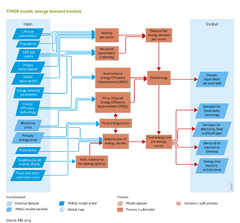Energy demand: Difference between revisions
Jump to navigation
Jump to search
No edit summary |
No edit summary |
||
| Line 3: | Line 3: | ||
|IMAGEComponent=Energy supply and demand; Energy conversion; Energy supply; Scenario drivers; Human development; Forest management; | |IMAGEComponent=Energy supply and demand; Energy conversion; Energy supply; Scenario drivers; Human development; Forest management; | ||
|KeyReference=Daioglou et al., 2012; Girod et al., 2012; Van Ruijven et al., 2012; | |KeyReference=Daioglou et al., 2012; Girod et al., 2012; Van Ruijven et al., 2012; | ||
|InputVar=GDP per capita; Sector value added; Private consumption; Population; Energy intensity parameters; Energy efficiency technology; Primary energy price; Electricity price; Lifestyle parameters; | |InputVar=GDP per capita; Sector value added; Private consumption; Population; Energy intensity parameters; Energy efficiency technology; Primary energy price; Electricity price; Lifestyle parameters; Taxes and other additional costs; Preferences; | ||
|Parameter=Exogenously set market shares; | |||
|OutputVar=Demand for electricity, heat and hydrogen; Demand traditional biomass; People dependent on solid fuel; Energy and industry activity level; Demand for fossil fuels and bioenergy; | |OutputVar=Demand for electricity, heat and hydrogen; Demand traditional biomass; People dependent on solid fuel; Energy and industry activity level; Demand for fossil fuels and bioenergy; | ||
|Description=Global energy use has increased rapidly since the industrial revolution. For a historical perspective, most increases have occurred in high-income regions but more recently, the largest increase is in emerging economies. With the aspirations for income growth in medium- and low-income countries, energy demand is to be expected to grow in the coming decades, with major implications for sustainability. | |Description=Global energy use has increased rapidly since the industrial revolution. For a historical perspective, most increases have occurred in high-income regions but more recently, the largest increase is in emerging economies. With the aspirations for income growth in medium- and low-income countries, energy demand is to be expected to grow in the coming decades, with major implications for sustainability. | ||
Revision as of 09:40, 6 May 2014
| Component is implemented in: |
|
| Related IMAGE components |
| Projects/Applications |
| Key publications |
Key policy issues
- How will energy demand evolve particularly in emerging and medium- and low-income economies?
- What is the mix of end-use energy carriers to meet future energy demand?
- How can energy efficiency contribute to reducing the growth rate of energy demand and mitigate pressures on the global environment?
